
Do you have a question about the powersoft K6/K6 DSP + AESOP and is the answer not in the manual?
| Amplifier Technology | Class D |
|---|---|
| Number of Channels | 2 |
| DSP | Yes |
| AESOP | Yes |
| AC Power | 100-240V, 50/60Hz |
| Power Supply | Switching mode |
| AES/EBU Input | Yes |
| Network Control | Yes |
| Damping Factor | >500 |
| Damping Factor @ 8Ω | >500 |
| Protection | short circuit, DC |
Crucial safety guidelines for operating the amplifier safely and preventing hazards.
Compliance details and certifications for the product according to electrical codes and standards.
Specific warnings and cautions related to installation, usage, and potential risks.
General rules for safe operation, including electrical connections and environmental considerations.
Information on preventing damage to loudspeakers due to the amplifier's high power output.
Warning about potential electrical shock from exposed speaker wiring during operation.
Diagram identifying components and controls on the front panel of the K Series amplifier.
Diagram showing connectors and features on the rear panel of the K2/K3 2-port amplifier.
Diagram showing connectors and features on the rear panel of the K2/K3 4-port amplifier.
Diagram showing connectors and features on the rear panel of K6/K8/K10/K20 2-port amplifiers.
Diagram showing connectors and features on the rear panel of K6/K8/K10/K20 4-port amplifiers.
Detailed view of the K Series front panel, identifying various controls and indicators.
Welcome message and overview of the Powersoft K Series amplifier's capabilities and applications.
Highlights advanced features, digital control, and Power Factor Correction of the K Series amplifiers.
Discusses the benefits of Class D technology, offering high efficiency and reduced size/weight.
Emphasizes the amplifier's reliability and protection features for uninterrupted operation.
Instructions for carefully unpacking the amplifier and checking for any shipping damage.
Guidance on securely mounting the amplifier in a standard 19" rack using front and rear holes.
Explains the forced-air cooling system, including fan operation and temperature control.
Important precautions before connecting inputs/outputs and regarding AC mains voltage.
Details on the amplifier's grounding system and the importance of the safety earth connection.
Instructions for connecting the amplifier to the AC mains power, including voltage range and safety.
Guide to connecting analog audio signals via XLR or 1/4" jack connectors.
Detailed explanation of analog input pinouts and polarity for balanced/unbalanced signals.
How to select and connect AES/EBU digital audio inputs, including channel switching.
Instructions for connecting speakers using Neutrik speakon connectors in stereo or bridge mode.
Explanation of the amplifier's internal signal path polarity and its implications for audio quality.
Details on connecting remote control interfaces via V Ext, Serial (RS485), and Ethernet.
Description of the "V Ext" terminal for remotely turning the amplifier on/off or standby.
How to connect for remote control using RS485 and the "DATAPORT" RJ45 jack.
Connecting the amplifier via Ethernet for remote control using KAESOP board.
Overview of front panel controls, LCD display, and settings accessible for amplifier configuration.
Explanation of the main screen display and the function of front panel LED meters.
Description of the function and operation of the front panel buttons for menu navigation and control.
Setting the amplifier's output attenuation level for channel 1, 2, or both.
Selecting input sensitivity to match external equipment and adjust gain levels.
Choosing between analog, AES3, and KAESOP input sources for processing.
Setting the maximum output peak voltage levels for individual or combined channels.
Configuring the maximum current draw from mains to prevent breaker trips.
Preventing distortion by limiting excessive output signal amplitude for each channel.
Muting amplifier channels individually when input signal amplitude falls below a set threshold.
Automatically muting all channels when the amplifier is turned on for safety.
Enabling power saving by turning off output stages when no signal is detected.
Block diagram illustrating the advanced digital sound processor's signal flow.
Overview of the DSP settings structure, affecting single channels or both.
Settings affecting both channels, including source selection and network configuration.
Choosing the input signal (Stereo, Parallel, Mono Mix) to be processed by the DSP.
Configuring options for the AES3 digital input stream, including fallback behavior.
Adjusting the digital level of the AES3 input signal to match analog levels.
Defining amplifier behavior when the AES3 connection fails, options for mute or analog backup.
Mirroring gain reduction between channels to maintain consistent levels during power limiting.
Setting the sound velocity for time-to-distance conversions within the local interface.
Individual settings for channel 1 and channel 2, including EQ, delay, gain, and limiters.
Accessing the parametric output equalizer, allowing adjustment of 16 filters per channel.
Configuring crossover filters (low-pass, high-pass, band-pass) using IIR or FIR filter types.
Reversing the signal polarity for individual channels to ensure correct phase alignment.
Setting single channel output delay to time-align different loudspeakers.
Adjusting the channel gain level over a range from -40dB to +15dB.
Protecting loudspeakers from damage using Peak and RMS limiters.
Adding a virtual series resistor to optimize damping factor with any cabling.
Applying an additional input delay independent of the input EQ settings.
Tools to test input/output line integrity and measure impedance at specific frequencies.
Enabling or disabling the input processing block for EQ and other settings.
Disabling input processing and resetting aux delay to zero.
Disabling all output EQ, limiters, and damping functions.
Overview of the AESOP standard for bidirectional Ethernet and AES3 digital audio transport.
Details on the 100 Mbit Ethernet connectivity, dual port design, and topology options.
How audio is distributed via AESOP protocol using two independent AES3 streams.
Explains repeater and forwarder modes for building amplifier networks.
Setting the amplifier's mode (Repeater, Forward) concerning AES3 streams.
Controlling IP addressing strategy (Manual or Automatic DHCP).
Manually setting the amplifier's IP address, subnet mask, and default gateway.
Displaying the current network configuration details of the amplifier.
Selecting the AES3 stream source and mode for output.
Choosing the AES3 stream source (XLR, RJ45 ports) for the amplifier's output stage.
Selecting how channel audio data is forwarded to the output stage.
Adjusting the digital level of the AES3 stream for optimal analog signal matching.
Defining behavior upon digital audio stream loss, with options for mute or analog backup.
Displaying output signal information like RMS voltage, current, power, and load impedance.
Showing the current internal amplifier temperature.
Displaying updated mains RMS voltage and current levels with numbers and progress bars.
Accessing functions to display or edit the amplifier's name and current preset.
Preventing presets from being overwritten by enabling a lock function with a code.
Setting the number of locally stored presets that cannot be overwritten.
Loading a previously saved amplifier setup from the local memory.
Saving the current amplifier configuration as a preset to local memory.
Modifying the user code required to activate or deactivate the "lock presets" function.
Deleting all non-write protected presets stored in the amplifier's internal memory.
Accessing detailed information about the amplifier's hardware components and firmware versions.
Monitoring current amplifier system parameters like power supply voltages and clock status.
Adjusting the contrast level of the front panel LCD display for better readability.
Activating front panel lock and setting an unlock code to prevent unauthorized changes.
Muting individual channels directly from the front panel without affecting other functions.
Amplifier outputs are muted during power on/off to prevent speaker damage.
Protecting the amplifier from damage caused by short circuits or low impedance loads.
Monitoring internal temperature and muting outputs or shutting down if overheating occurs.
Cutting power to channels if a DC signal or excessive subsonic energy is detected at the output.
Protecting loudspeakers from strong high-frequency signals above the audible range.
Instructions for cleaning the amplifier's exterior using soft cloths and mild solutions.
Guidance on obtaining servicing from qualified personnel or authorized service centers.
Procedures for cleaning front air filters to maintain optimal cooling performance.
Details on the 48-month warranty period, coverage, and exclusions.
Procedures for returning defective products, including obtaining an RMA number.
Powersoft's policy on repairing or replacing defective goods under warranty.
Information on building a custom box to combine Ethernet and AES3 signals for network applications.
List and explanation of error codes displayed on the main screen for troubleshooting.
Using SmartCards for storing and recalling amplifier presets and firmware updates.
Details on Powersoft's Armonía Pro Audio Suite for amplifier control and monitoring.
Features and connectivity options of the Armonía software for managing K Series amplifiers.
Information on using plug-ins for third-party control of K Series amplifiers.
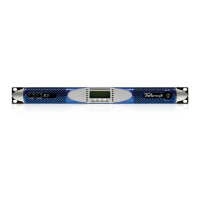



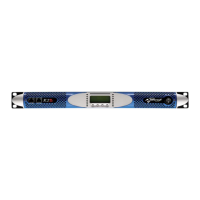
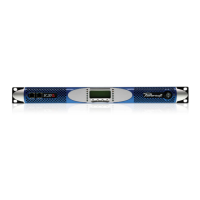


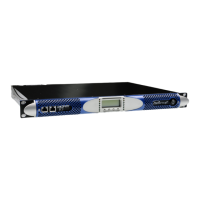
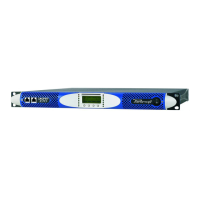
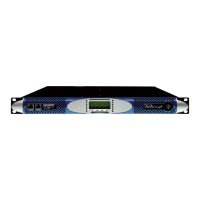

